Abstract
We investigated the effects of the combination of azlocillin with the beta-lactamase inhibitors clavulanic acid and sulbactam and with N-formimidoyl thienamycin against strains of Pseudomonas aeruginosa with R-factor-mediated carbenicillin resistance. The 10 strains tested (1 R-, 9 R+) were isogenic, except for the presence of individual plasmids determining each of nine plasmid-mediated beta-lactamases found in P. aeruginosa. We utilized a checkerboard technique for testing antibiotic combinations. Low concentrations of clavulanic acid produced synergy with azlocillin against the strains producing the TEM-1, TEM-2, PSE-1, PSE-3, and PSE-4 beta-lactamases; for the strains producing the OXA-1, OXA-2, OXA-3, and PSE-2 beta-lactamases, such synergy was not found. With sulbactam, synergy was demonstrated in all strains except that producing PSE-2 beta-lactamase; for several strains, however, the concentration of sulbactam required to produce synergy was substantially higher than that for clavulanic acid. N-Formimidoyl thienamycin was highly active as a single agent against all of the strains, regardless of beta-lactamase production. The combination of N-formimidoyl thienamycin and azlocillin produced synergy against only two of the strains tested.
Full text
PDF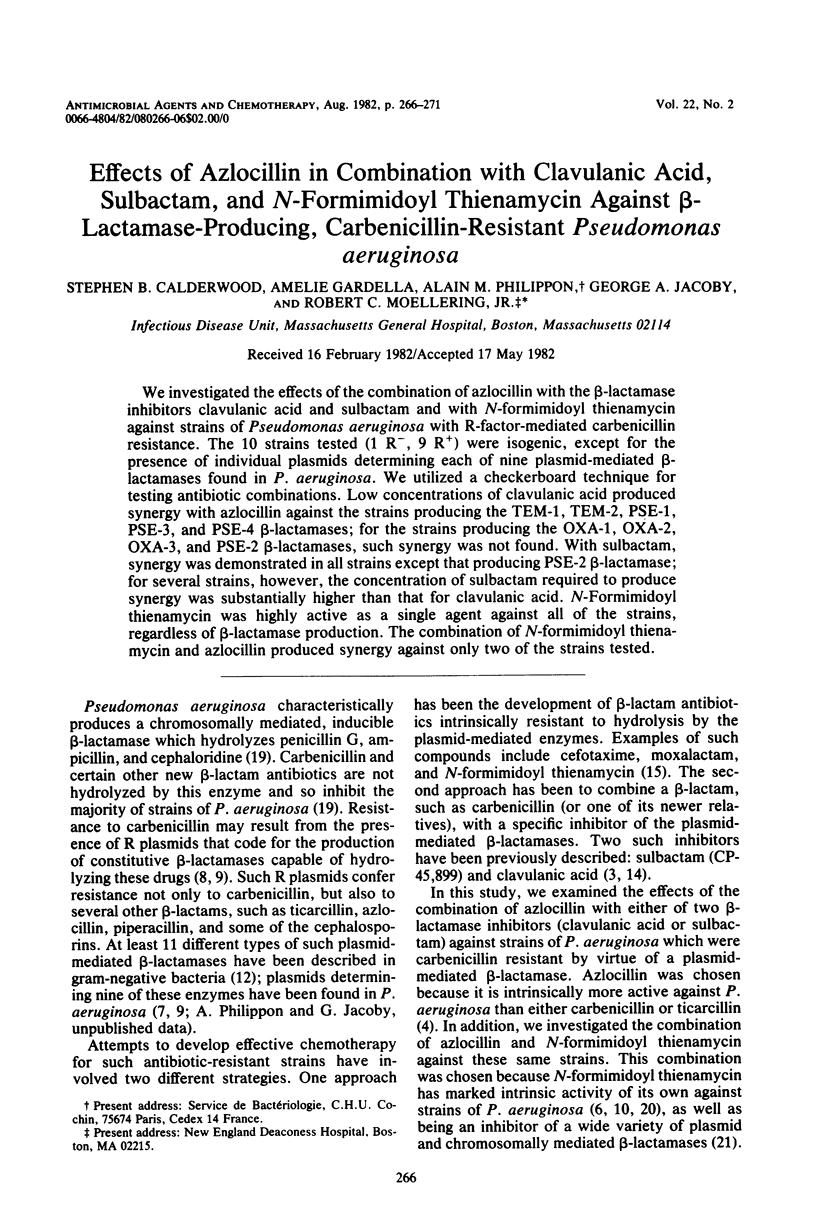
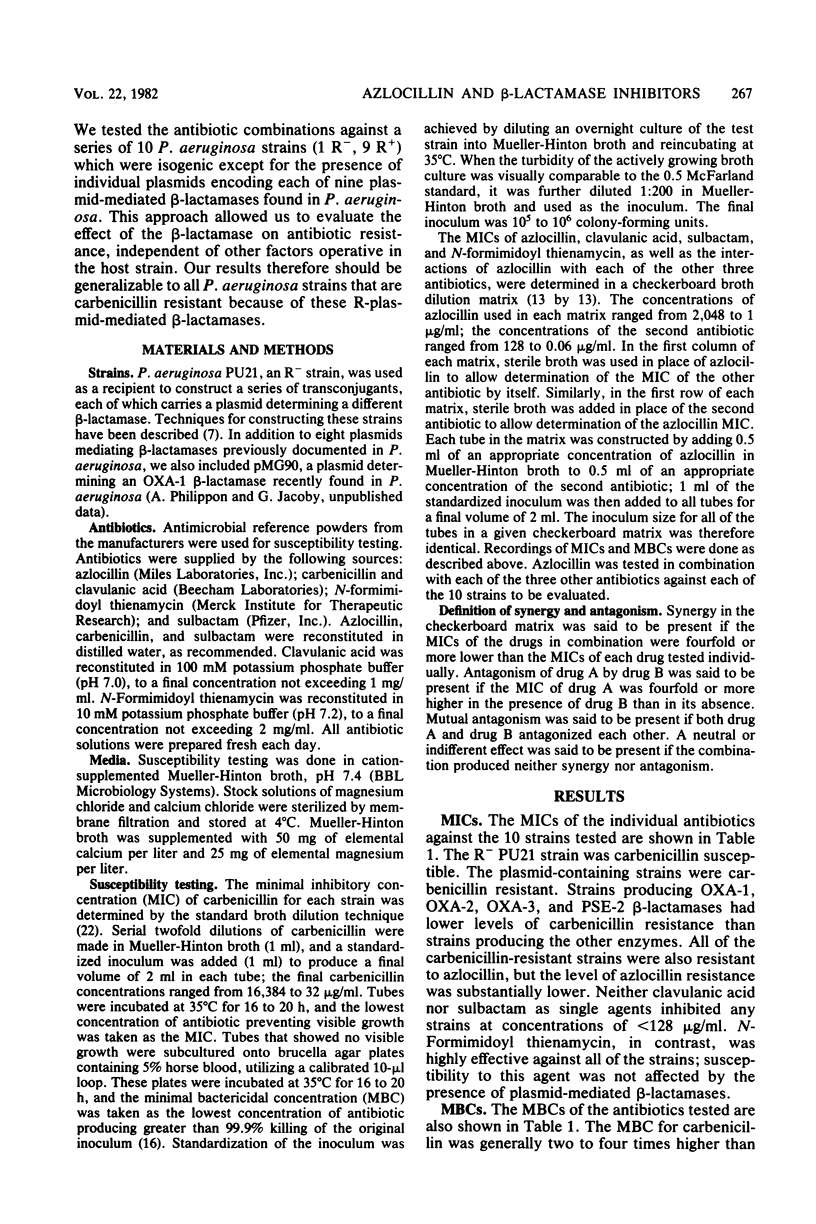
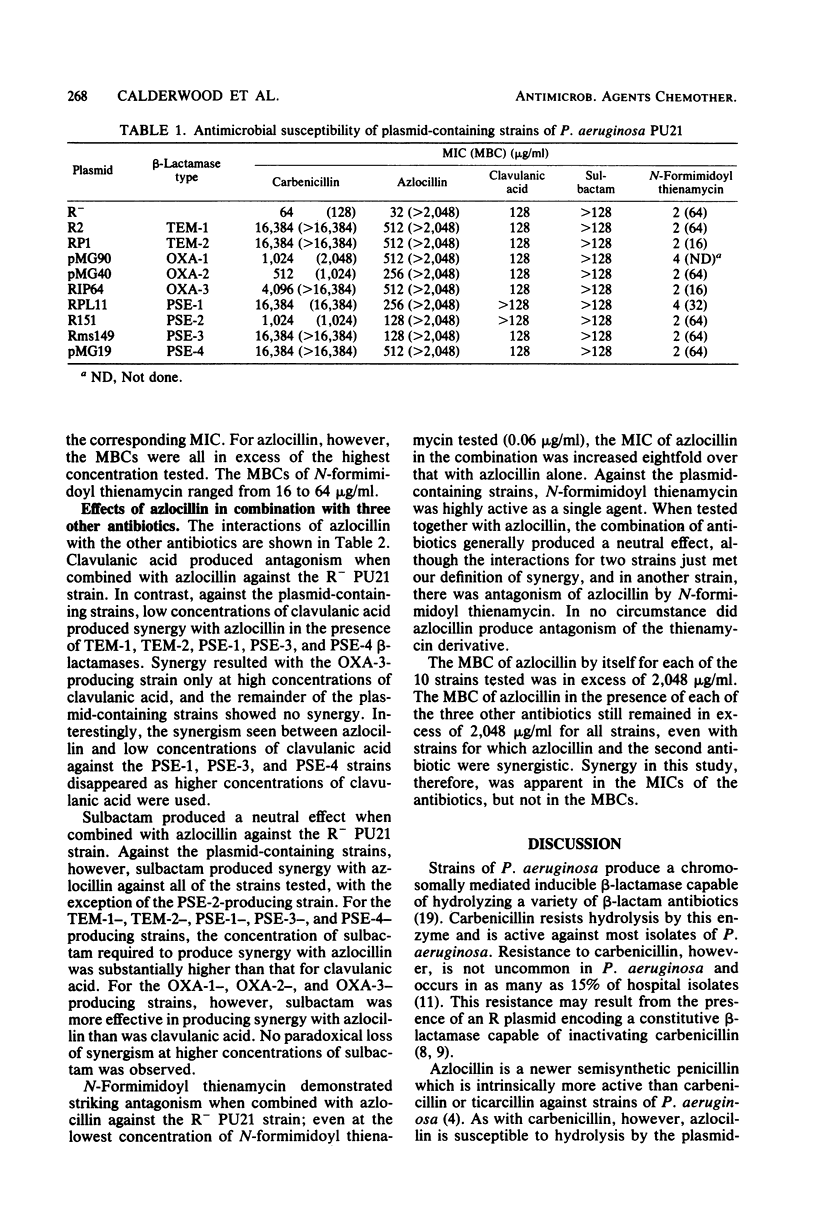
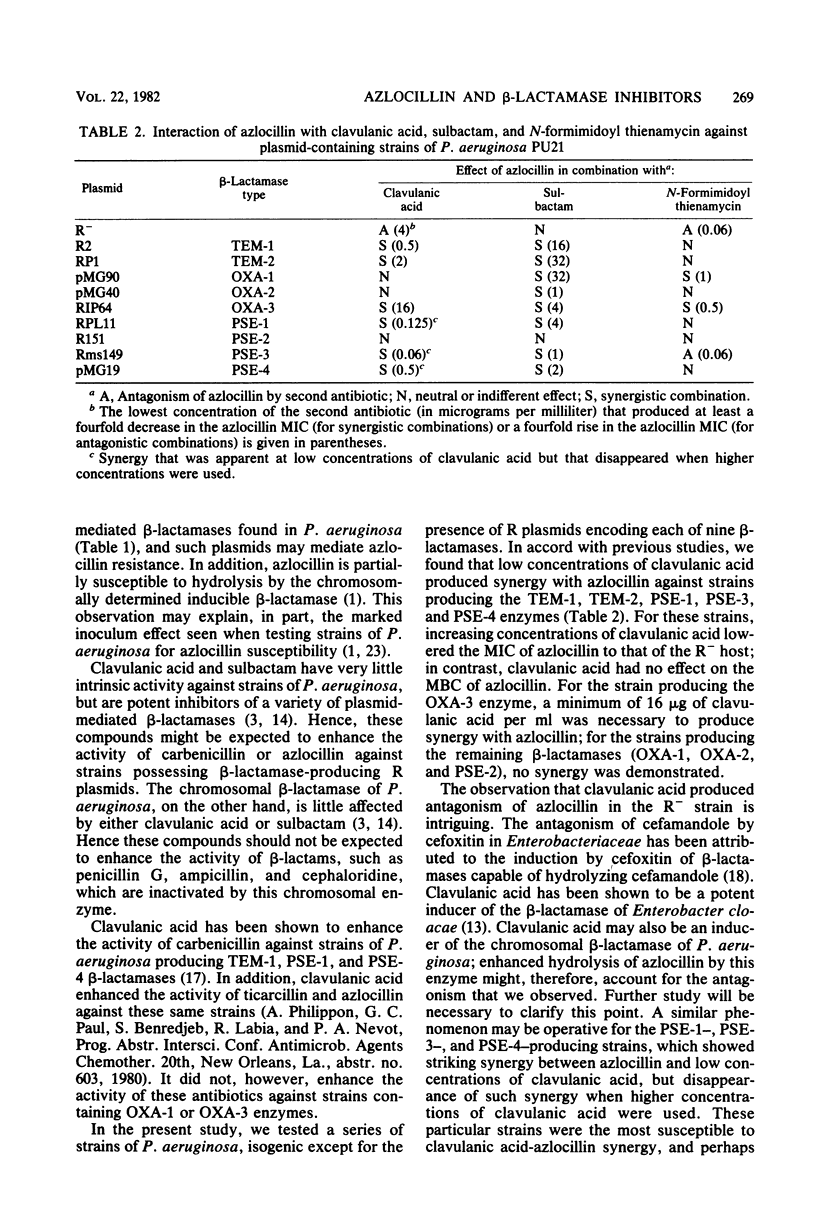
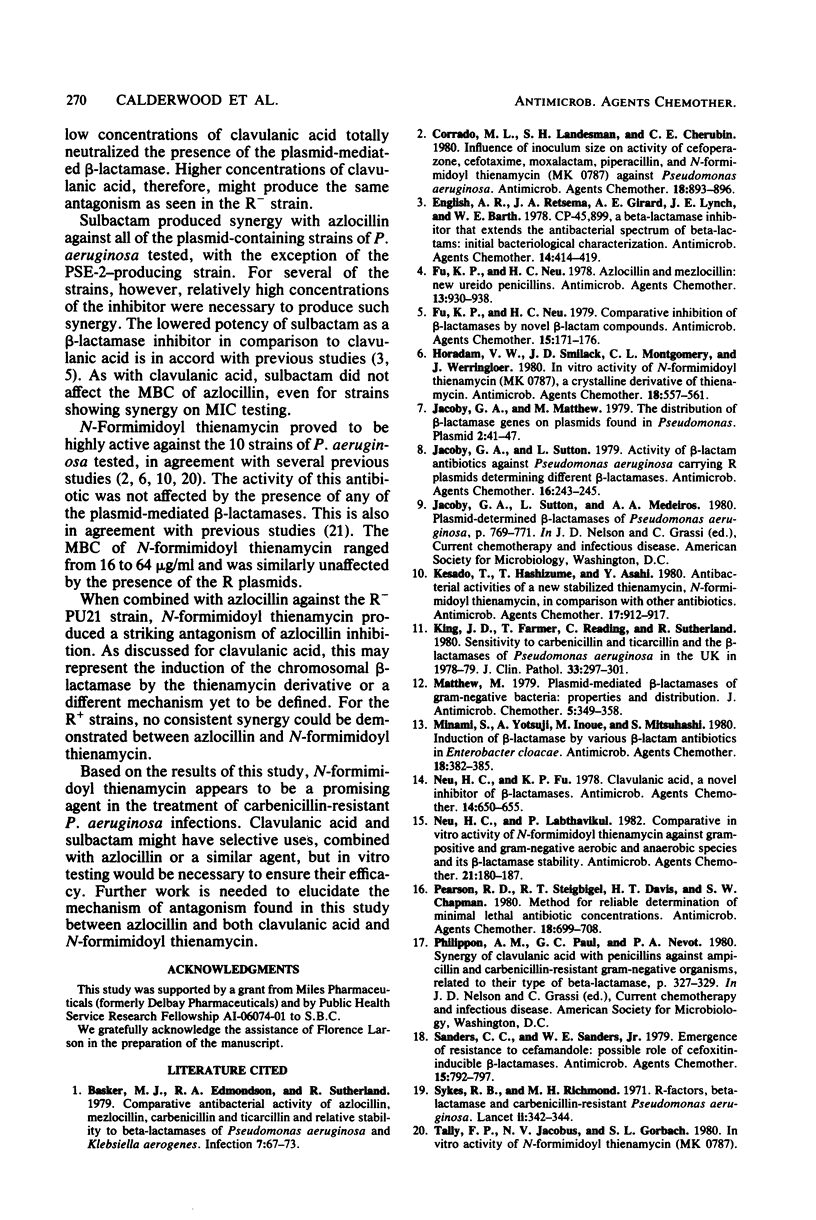
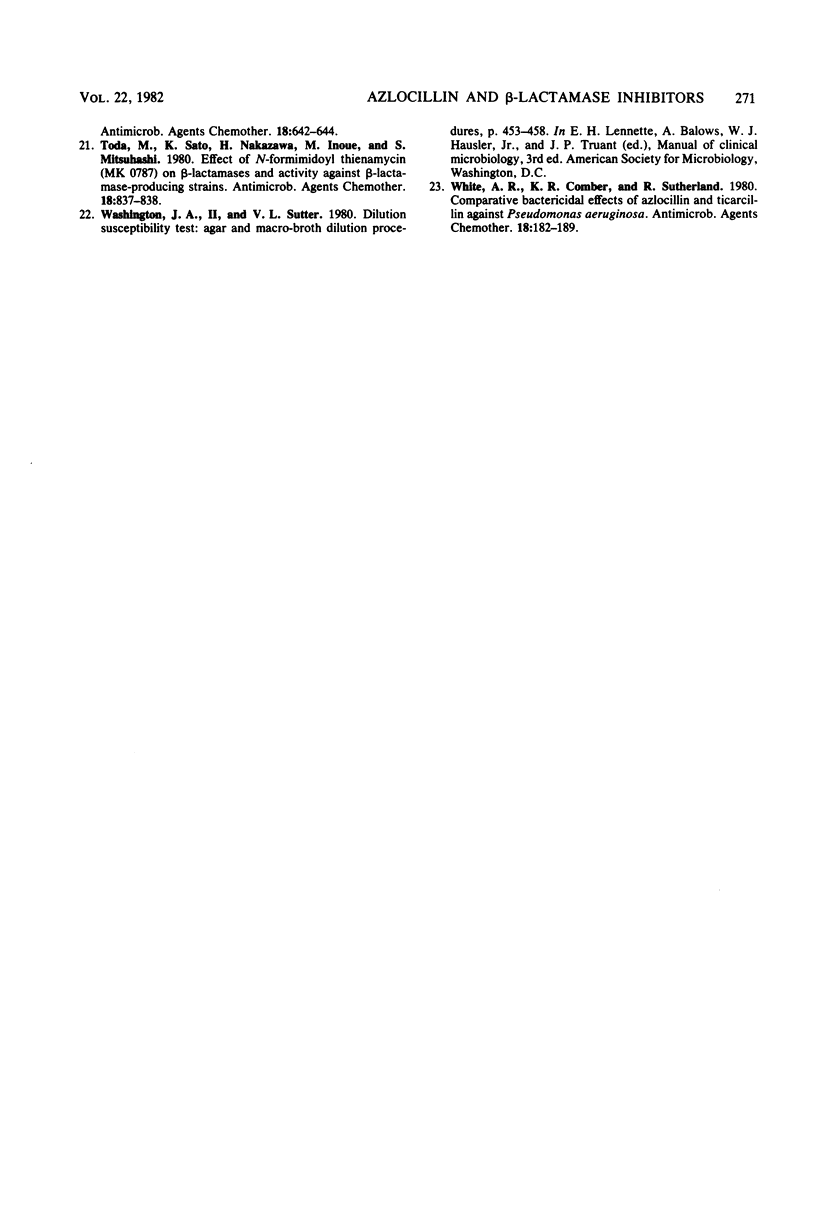
Selected References
These references are in PubMed. This may not be the complete list of references from this article.
- Basker M. J., Edmondson R. A., Sutherland R. Comparative antibacterial activity of azlocillin, mezlocillin, carbenicillin and ticarcillin and relative stability to beta-lactamases of pseudomonas aeruginosa and klebsiella aerogenes. Infection. 1979;7(2):67–73. doi: 10.1007/BF01641616. [DOI] [PubMed] [Google Scholar]
- Corrado M. L., Landesman S. H., Cherubin C. E. Influence of inoculum size on activity of cefoperazone, cefotaxime, moxalactam, piperacillin, and N-formimidoyl thienamycin (MK0787) against Pseudomonas aeruginosa. Antimicrob Agents Chemother. 1980 Dec;18(6):893–896. doi: 10.1128/aac.18.6.893. [DOI] [PMC free article] [PubMed] [Google Scholar]
- English A. R., Retsema J. A., Girard A. E., Lynch J. E., Barth W. E. CP-45,899, a beta-lactamase inhibitor that extends the antibacterial spectrum of beta-lactams: initial bacteriological characterization. Antimicrob Agents Chemother. 1978 Sep;14(3):414–419. doi: 10.1128/aac.14.3.414. [DOI] [PMC free article] [PubMed] [Google Scholar]
- Fu K. P., Neu H. C. Azlocillin and mezlocillin: new ureido penicillins. Antimicrob Agents Chemother. 1978 Jun;13(6):930–938. doi: 10.1128/aac.13.6.930. [DOI] [PMC free article] [PubMed] [Google Scholar]
- Fu K. P., Neu H. C. Comparative inhibition beta-lactamases by novel beta-lactam compounds. Antimicrob Agents Chemother. 1979 Feb;15(2):171–176. doi: 10.1128/aac.15.2.171. [DOI] [PMC free article] [PubMed] [Google Scholar]
- Horadam V. W., Smilack J. D., Montgomery C. L., Werringloer J. In vitro activity of N-formimidoyl thienamycin (MK0787), a crystalline derivative of thienamycin. Antimicrob Agents Chemother. 1980 Oct;18(4):557–561. doi: 10.1128/aac.18.4.557. [DOI] [PMC free article] [PubMed] [Google Scholar]
- Jacoby G. A., Matthew M. The distribution of beta-lactamase genes on plasmids found in Pseudomonas. Plasmid. 1979 Jan;2(1):41–47. doi: 10.1016/0147-619x(79)90004-0. [DOI] [PubMed] [Google Scholar]
- Jacoby G. A., Sutton L. Activity of beta-lactam antibiotics against Pseudomonas aeruginosa carrying R plasmids determining different beta-lactamases. Antimicrob Agents Chemother. 1979 Aug;16(2):243–245. doi: 10.1128/aac.16.2.243. [DOI] [PMC free article] [PubMed] [Google Scholar]
- Kesado T., Hashizume T., Asahi Y. Antibacterial activities of a new stabilized thienamycin, N-formimidoyl thienamycin, in comparison with other antibiotics. Antimicrob Agents Chemother. 1980 Jun;17(6):912–917. doi: 10.1128/aac.17.6.912. [DOI] [PMC free article] [PubMed] [Google Scholar]
- King J. D., Farmer T., Reading C., Sutherland R. Sensitivity to carbenicillin and ticarcillin, and the beta-lactamases of Pseudomonas aeruginosa in the UK in 1978-79. J Clin Pathol. 1980 Mar;33(3):297–301. doi: 10.1136/jcp.33.3.297. [DOI] [PMC free article] [PubMed] [Google Scholar]
- Matthew M. Plasmid-mediated beta-lactamases of Gram-negative bacteria: properties and distribution. J Antimicrob Chemother. 1979 Jul;5(4):349–358. doi: 10.1093/jac/5.4.349. [DOI] [PubMed] [Google Scholar]
- Minami S., Yotsuji A., Inoue M., Mitsuhashi S. Induction of beta-lactamase by various beta-lactam antibiotics in Enterobacter cloacae. Antimicrob Agents Chemother. 1980 Sep;18(3):382–385. doi: 10.1128/aac.18.3.382. [DOI] [PMC free article] [PubMed] [Google Scholar]
- Neu H. C., Fu K. P. Clavulanic acid, a novel inhibitor of beta-lactamases. Antimicrob Agents Chemother. 1978 Nov;14(5):650–655. doi: 10.1128/aac.14.5.650. [DOI] [PMC free article] [PubMed] [Google Scholar]
- Neu H. C., Labthavikul P. Comparative in vitro activity of N-formimidoyl thienamycin against gram-positive and gram-negative aerobic and anaerobic species and its beta-lactamase stability. Antimicrob Agents Chemother. 1982 Jan;21(1):180–187. doi: 10.1128/aac.21.1.180. [DOI] [PMC free article] [PubMed] [Google Scholar]
- Pearson R. D., Steigbigel R. T., Davis H. T., Chapman S. W. Method of reliable determination of minimal lethal antibiotic concentrations. Antimicrob Agents Chemother. 1980 Nov;18(5):699–708. doi: 10.1128/aac.18.5.699. [DOI] [PMC free article] [PubMed] [Google Scholar]
- Sanders C. C., Sanders W. E., Jr Emergence of resistance to cefamandole: possible role of cefoxitin-inducible beta-lactamases. Antimicrob Agents Chemother. 1979 Jun;15(6):792–797. doi: 10.1128/aac.15.6.792. [DOI] [PMC free article] [PubMed] [Google Scholar]
- Sykes R. B., Richmond M. H. R factors, beta-lactamase, and carbenicillin-resistant Pseudomonas aeruginosa. Lancet. 1971 Aug 14;2(7720):342–344. doi: 10.1016/s0140-6736(71)90060-2. [DOI] [PubMed] [Google Scholar]
- Tally F. P., Jacobus N. V., Gorbach S. L. In vitro activity of N-formimidoyl thienamycin (MK0787). Antimicrob Agents Chemother. 1980 Oct;18(4):642–644. doi: 10.1128/aac.18.4.642. [DOI] [PMC free article] [PubMed] [Google Scholar]
- Toda M., Sato K., Nakazawa H., Inoue M., Mitsuhashi S. Effect of N-formimidoyl thienamycin (MK0787) on beta-lactamases and activity against beta-lactamase-producing strains. Antimicrob Agents Chemother. 1980 Nov;18(5):837–838. doi: 10.1128/aac.18.5.837. [DOI] [PMC free article] [PubMed] [Google Scholar]
- White A. R., Comber K. R., Sutherland R. Comparative bactericidal effects of azlocillin and ticarcillin against Pseudomonas aeruginosa. Antimicrob Agents Chemother. 1980 Jul;18(1):182–189. doi: 10.1128/aac.18.1.182. [DOI] [PMC free article] [PubMed] [Google Scholar]


